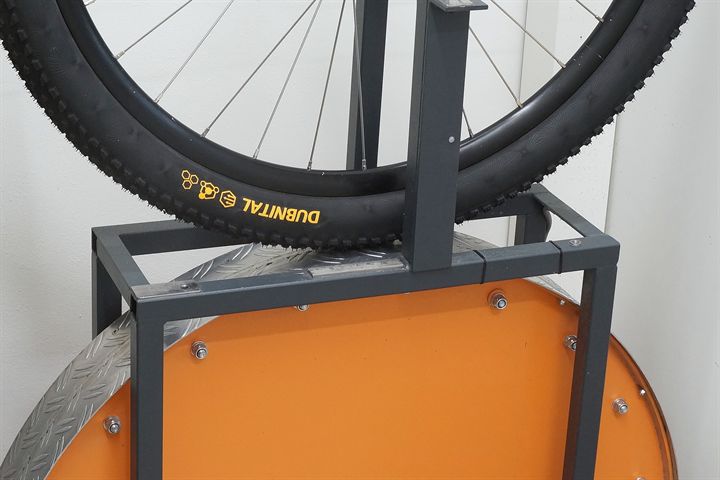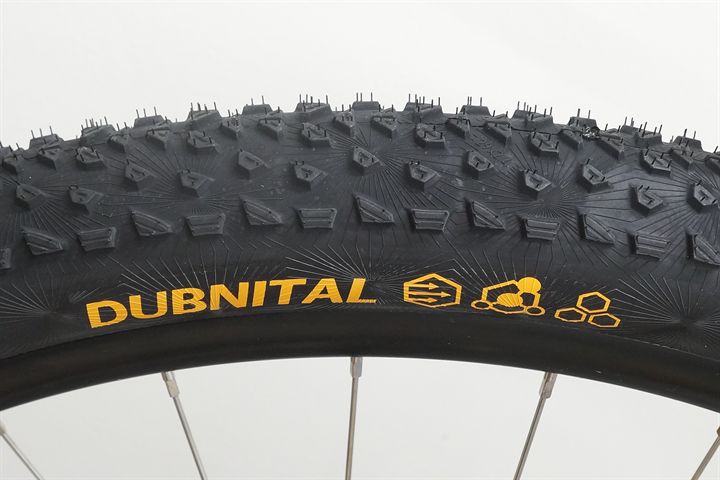Tire Lab Test: Continental Dubnital Race Grip 29x2.4
Contents and Test Summary
- Introduction
- Manufacturer Specifications
- Size, Weight, Thickness
- Rolling Resistance: 26.5 Watts
- Puncture Resistance: 41 Points
- Static Wet Grip: 71 Points
- Conclusion: 4.3 / 5 Highly Recommended
- Comments
- Continental Dubnital Race Grip 2.4

As many of you already know, Continental has recently released a completely new lineup of mountain bike tires. With this release, Continental has introduced new casings and compounds. Unlike their old lineup (Race King, Cross King, Mountain King), you can now choose from different casings and compounds for each tire to arrive at the ideal tire for your individual needs.
We have already tested several tires from Continental's new lineup (Dubnital Race Rapid 2.4 and 2.2, Trinotal Race Rapid 2.4), but all of these had the Race casing and Rapid compound. Today, we will look at the difference between the Rapid compound and Grip compound, which is likely the most important comparison for many of you following the introduction of Continental's new mountain bike lineup.
The Dubnital is the most popular tire in Conti's new lineup so far, and it is the ideal tire to make an initial comparison. We have tested both tires in the 29x2.4 size, making it easy to clearly map out the differences. Our test results will also help estimate differences across the rest of Conti's lineup that are available with both the Rapid and Grip compounds.
On paper, the specified weight of the version with Grip compound is slightly higher (5 grams) than the version with Rapid compound. In practice, the difference between the samples we purchased and tested is 29 grams. We need to be mindful of this with these kinds of comparisons, because if you get a lighter sample, it will always roll a fraction faster.
Let's quickly move on to the test results and outline the differences between the Continental Rapid and Grip compound. This test has, as always, been made possible by the support of our Pro Members. Would you like access to all test data and have a say in which tires will be tested in the future? Please sign up and support independent tire testing.
Manufacturer Specifications
| Manufacturer Specs | |
|---|---|
| Brand | Continental |
| Model | Dubnital Race Grip |
| Year | 2025 |
| Supplied By | Bought in store |
| New or Used | New |
| Mileage | 0 km |
| Price Range | High |
| Buy At | |
| Manufacturer part number | 01020390000 |
| EAN | 4019238402582 |
| TPI | 3/330 |
| Compound | Grip Compound |
| Bead | Folding |
| ETRTO | 60-622 |
| Size Inch | 29" |
| Width Inch | 2.40 |
| Specified Weight | 650 grams |
| Max Air Pressure (psi) | 50 |
| Made In | Pro Data |
| Available Sizes |
29x2.20 29x2.40 |
Continental Dubnital Race Grip Test Results

Size, Weight, and Thickness Measurements
| Size, Weight, and Thickness Measurements | |
|---|---|
| Specified Weight | 650 grams |
| Measured Weight | 664 grams |
| Measured Width Carcass | 56 mm (un-round) |
| Measured Width Tread | 58 mm |
| Measured Height | Pro Data |
| Tire Circumference | Pro Data |
| Measured Knob Height Center | 2.4 mm |
| Measured Knob Height Edge | 3.9 mm |
| Measured Total Thickness Center (excluding knobs) | 2.5 mm |
| Measured Total Thickness Sidewall | Pro Data |
| All size measurements are taken at an air pressure of 35 psi / 2.4 bars on a 17.8 mm inner width rim. | |
Rolling Resistance Test Results
| Rolling Resistance Test Results | |
|---|---|
| Inner Tube | None (40 ml sealant) |
| Measured Width | 56 mm |
| Rolling Resistance Real tire width in mm: 47-50 = 42 psi/2.9 bar 51-55 = 38 psi/2.6 bar 56-60 = 34 psi/2.3 barHigh Air Pressure (34 psi / 2.3 bar) |
Pro Data |
| Rolling Resistance Real tire width in mm: 47-50 = 35 psi/2.4 bar 51-55 = 32 psi/2.2 bar 56-60 = 29 psi/2.0 barMedium Air Pressure (29 psi / 2.0 bar) |
Pro Data |
| Rolling Resistance Real tire width in mm: 47-50 = 28 psi/1.9 bar 51-55 = 25 psi/1.7 bar 56-60 = 23 psi/1.6 barLow Air Pressure (23 psi / 1.6 bar) |
26.5 Watts CRR: 0.00794 |
| Rolling Resistance Real tire width in mm: 47-50 = 21 psi/1.4 bar 51-55 = 19 psi/1.3 bar 56-60 = 17 psi/1.2 barExtra Low Air Pressure (17 psi / 1.2 bar) |
Pro Data |
| The MTB section is a multi tire size section, air pressures have been adjusted to the measured casing width. All numbers are for a single tire at a speed of 29 km/h / 18 mph and a load of 42.5 kg / 94 lbs. Use the formula: RR (Watts) = CRR * speed (m/s) * load (N) to calculate rolling resistance at a given speed and load. |
|
Puncture Resistance Test Results

| Puncture Resistance Test Results (higher is better) | |
|---|---|
| Total Puncture Score Tread | 41 Points |
| Total Puncture Score Sidewall | Pro Data |
| Tread Puncture Force Sharp Needle | Pro Data |
| Tread Puncture Force Blunt Needle | Pro Data |
| Tread Total Tire Thickness | 2.5 mm |
| Sidewall Puncture Force Sharp Needle | Pro Data |
| Sidewall Puncture Force Blunt Needle | Pro Data |
| Sidewall Total Tire Thickness | Pro Data |
Hard Surface Static Grip Test Results

| Static Grip Test Results | |
|---|---|
| Wet Grip Average | 71 Points |
| Wet Grip Center | Pro Data |
| Wet Grip Edge | Pro Data |
| Measured Knob Height Center | 2.4 mm |
| Measured Knob Height Edge | 3.9 mm |
| Grip in points = coefficient of friction * 100 MTB grip test rim width = 30.0 mm |
|
| Wet Grip Test and Off-Road Tires (info) | |
Conclusion
- Continental Dubnital Race Grip 2.4
(100% is fastest - lightest - highest - strongest)
The Continental Dubnital Race Grip performs approximately as we expected. The significant difference between the versions with the Race and Grip compounds is seen in the rolling resistance tests, where the Grip compound version rolls about 30% slower. In the other tests, we didn't observe any differences exceeding the test's margin of error.
The most striking point is that our wet grip test on a hard surface shows virtually no difference; we can therefore assume that on a hard surface, the grip for both tires is roughly equal. However, we do expect that, although our test does not demonstrate this, the Grip compound may offer more grip in off-road conditions than the Rapid compound.
Why do we think this? In our grip tests on a hard surface, we reach the maximum grip the tire can provide, and with tread-pattern tires, we quickly reach the limits of tread flex. On slippier off-road surfaces, the maximum grip will never be reached, and the compound's grip becomes more important.
If we assume that both tires score 70 points on our hard-surface test, it's possible that on a surface offering 50% less grip, tire A could still provide 40 points of grip while tire B may only offer 30 points. In the case of Conti's Rapid and Grip compound, we must trust that, in off-road conditions, the compound the manufacturer deems most grippy will indeed provide more grip.
Looking at our tests from a different angle, we could also say that the difference between the compounds is not significant enough. This conclusion aligns with our earlier conclusion that the Dubnital with Race compound is a strong-performing tire, but when compared to the Race King, which was praised for its speed, it's by no means fast enough.
Based purely on our test results, we see that the Dubnital with Grip compound is overall a less performing tire than its sibling with Rapid compound.
Compare the Dubnital Race Rapid and Dubnital Race Grip on our comparison section.
RATING:
4.3
/ 5
TEST VERDICT:
Highly Recommended
